Wing Kitesurfing: An In-Depth Exploration of the Sport
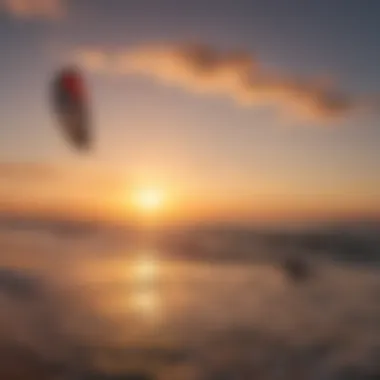
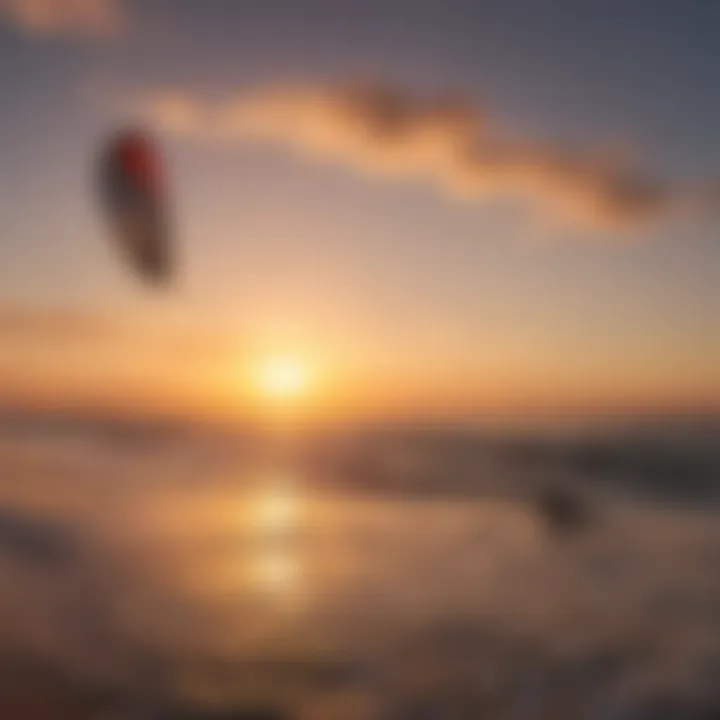
Intro
Wing kitesurfing represents a fascinating segment of the extreme sports universe. This activity harnesses both the thrill of surfing and the exhilarating power of wind through a wing, allowing riders to glide across water with incredible speed and agility. As this sport continues to grow in popularity, understanding its unique attributes becomes essential for both newcomers and experienced athletes. The following sections will offer a detailed exploration of wing kitesurfing, focusing on its gear, techniques, ideal locations, and training resources.
Extreme Sports Overview
Definition of Extreme Sports
Extreme sports encompass activities that involve an inherent level of risk and require a significant degree of skill. These sports often take place in unconventional environments, offering participants the thrill of adrenaline as they push their physical and mental limits. Wing kitesurfing falls well within this definition, combining elements of both kiteboarding and windsurfing in an engaging water sport.
History and Evolution
Wing kitesurfing emerged from the broader kitesurfing movement, which began gaining traction in the late 20th century. The entry of inflatable wings into the market has revolutionized the approach to wind-driven water sports. Originally, powered by kites, the sport evolved with the introduction of wings, which provide a greater degree of control and versatility. Riders now can engage with varying wind conditions and water environments, broadening the sport's appeal.
Popular Extreme Sports Disciplines
While focusing on wing kitesurfing, it is important to acknowledge other notable extreme sports. Activities like rock climbing, skateboarding, and base jumping also capture the spirit of thrill-seeking and skill-based challenges. These sports, much like wing kitesurfing, attract enthusiasts looking for new ways to engage with physical challenges and nature.
Gear and Equipment
Essential Gear for Different Sports
Every sport requires specific gear to ensure both performance and safety. For wing kitesurfing, the primary equipment consists of the wing and board. The wing itself has various sizes tailored for different wind conditions, allowing riders to adapt. The board, designed for stability and responsiveness, is crucial for maneuverability.
Gear Reviews and Comparisons
The market is saturated with options for wing kitesurfing gear. Brands like Duotone and Naish offer high-quality wings and boards that cater to varying skill levels. A thorough review process helps riders choose the right equipment based on their personal preferences and experience. Comparing features such as responsiveness, material durability, and ease of use can lead to better purchases.
Safety Ratings and Certifications
Ensuring safety while engaging in any extreme sport is paramount. Gear should come with safety ratings from recognized organizations, ensuring reliability during use. Riders should verify certifications to minimize the risk of injuries associated with equipment failure, which can lead to unnecessary accidents on the water.
Training and Preparation
Physical Conditioning and Fitness Tips
To excel in wing kitesurfing, physical condition is important. Riders should focus on developing core strength, balance, and flexibility. Exercises such as yoga and pilates can enhance physical readiness, while cardio workouts improve stamina. Being in top shape not only contributes to performance but also to overall safety while riding.
Mental Preparation Techniques
Mental resilience is equally important for extreme sports athletes. Visualization techniques, practiced by many elite athletes, can significantly improve performance. Imagining successful maneuvers aids in building confidence and reducing anxiety before hitting the water. Maintaining focus is essential to navigate both challenging maneuvers and unexpected weather changes.
Training Regimens for Various Sports
Setting a structured training regimen can greatly enhance progress. Riders can benefit from training specific to wing kitesurfing, but also draw elements from related sports. Incorporating varied practices like freestyle sessions, technique drills, and even simulations can build skills quickly and effectively.
Locations and Destinations
Top Destinations for Extreme Sports
The thrill of wing kitesurfing is contingent not only on equipment and skill but on the environment as well. Destinations that offer consistent winds and flat water are ideal for this sport. Locations like Maui in Hawaii and Cape Town in South Africa stand out for their favorable conditions and vibrant water sports communities.
Travel Tips and Guides
Traveling to kitesurfing hotspots requires careful planning. When traveling, one should consider wind patterns, regional weather, and local regulations. Furthermore, finding schools or rental services at these locations can streamline the process for beginners looking to learn and participate. Gathering resources on local conditions helps ensure a safe and enjoyable experience.
"Wing kitesurfing not only challenges the body but also fosters a deep connection with the elements. It's a sport that rewards dedication and passion."
Understanding Wing Kitesurfing
Wing kitesurfing is an emerging sport in the world of extreme sports. Understanding this sport is essential for both newcomers and experienced individuals looking to expand their skills. Unlike traditional kitesurfing, wing kitesurfing offers unique dynamics, allowing for different maneuvering techniques and a different experience on the water. The importance of grasping the core concepts cannot be understated, as they serve as the foundation for safe and effective participation.
A comprehensive understanding of wing kitesurfing includes its definition, history, essential gear, techniques, and safety measures. This section aims to provide a holistic view, highlighting the distinct aspects that set wing kitesurfing apart from its predecessors.
Definition and Concept
Wing kitesurfing combines elements of windsurfing and kitesurfing but relies on a wing that is held by the rider instead of being attached to a fixed point. This wing uses the wind to propel the rider across the water, with the rider typically standing on a board similar to a surfboard or a specialized hydrofoil board. This sport facilitates a unique interaction with the elements, emphasizing balance, steering, and control. Riders can generate lift and navigate through varying water conditions using the wing's orientation and positioning.
History and Evolution
Wing kitesurfing is a relatively new sport, emerging in the late 2010s. Its evolution can be traced back to the innovations in both kites and windsurfing. The first versions of inflatable wings were created by enthusiastic engineers seeking a new way to harness wind dynamically. As technology improved, so did the design of wings, boards, and safety equipment.
The sport quickly gained traction, attracting attention for its versatility and ease of learning. It offers a thrilling experience that differs from traditional kitesurfing. The increased demand for wing kitesurfing has led to more competition, better gear, and a growing community. As riders push the boundaries of what is possible, wing kitesurfing continues to evolve, drawing both casual enthusiasts and serious athletes.
Equipment Essentials
When venturing into the world of wing kitesurfing, having the right equipment is crucial for both enjoyment and safety. The sport demands specific tools and gear to navigate the unique challenges presented by wind and water. Understanding the various components enhances not just the performance but also the overall experience on the water. Choosing the right gear can significantly impact skills development and enjoyment of the sport.
The Wing
Types of Wings
Types of wings are central to wing kitesurfing. They determine how well a rider interacts with the wind. Primarily, there are three categories: inflatable wings, rigid wings, and hybrid versions that blend characteristics. Inflatable wings are popular due to their lightweight and buoyant quality, making them easier to handle, especially for beginners. Rigid wings, on the other hand, offer greater performance in high winds and superior response.
The key characteristic of inflatable wings is their versatility in various conditions. They adapt well to light winds. This is a significant advantage for those starting, as they can learn without being overpowered. However, rigid wings require more skill and experience, offering increased speed and control. Which wing to choose often depends on the rider's preference and weather conditions they will face.
Material Considerations
Material considerations are another important aspect. The fabric used in wings impacts durability and performance. Most wings are made from high-quality ripstop nylon or similar materials that resist tearing. The technology behind these materials allows for lightweight constructions, essential for maneuverability on the water.
A critical characteristic of these materials is their UV resistance. Such properties extend the life of the wings significantly, important for those who kite often. The downside might be the cost; high-performance materials can be more expensive. However, investing in quality gear can save money in the long run due to less frequent replacements.
Inflatable vs. Rigid Wings
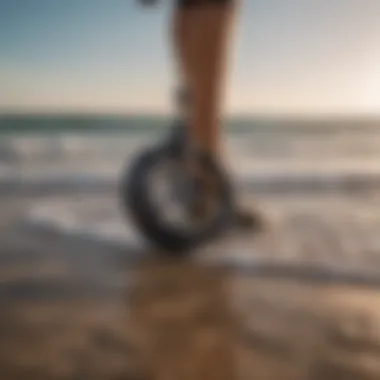
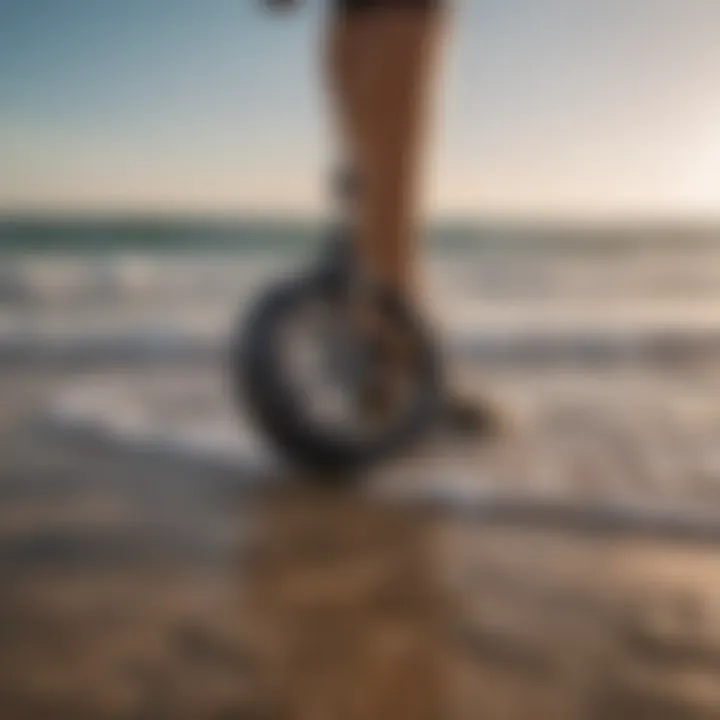
The comparison between inflatable and rigid wings is substantial. Inflatable wings offer convenience and safety, inflating quickly and reducing the risks during a fall. They are typically easier to transport and store, which benefits those who travel with their gear. Rigid wings, in contrast, are designed for performance, with a rigid frame that enhances stability and responsiveness.
Both types have their unique features. The inflatable wings are generally safer for beginners; they are forgiving in tough conditions. Rigid wings can provide more power and speed but require more finesse to control. Choices often depend on the rider's level and intended use, whether for leisure or sport.
Board Selection
Different Types of Boards
Board selection plays a vital role in wing kitesurfing. Various types of boards are available tailored for different styles and conditions, including traditional boards, foil boards, and hybrid designs. Each type serves a unique purpose; for instance, foil boards allow riders to glide above the water surface, offering a distinct sensation of flight.
The main characteristic of traditional boards is their stability on flat bodies of water. They provide a more predictable feel, which can build confidence for beginners. On the other hand, foil boards present a learning curve but can deliver an exhilarating experience once mastered. Opting for the right type depends on the rider's experience level and preferences for water conditions.
Size and Shape Considerations
Size and shape considerations are crucial in selecting a board. A wider board provides more stability, making it easier to learn maneuvers, while a narrower board allows for quicker turns. Riders must also think about length; shorter boards are more maneuverable but less stable at slower speeds.
The key point here is that size affects performance significantly. A board too big or too small can hinder a rider's ability to control their movements effectively. Understanding these dynamics contributes to a more suitable choice that complements a rider's style.
Harness and Accessories
Harness Types
Harness types are equally critical in ensuring comfort and connection to the wing. There are two primary harness types: seat harnesses and waist harnesses. Seat harnesses sit lower on the body and offer more support, ideal for those who enjoy aggressive riding. Waist harnesses provide more freedom of movement, which helps with tricks and maneuverability.
The notable characteristic of seat harnesses is their increased comfort for prolonged sessions. However, waist harnesses can lead to less fatigue during dynamic movements. The choice often depends on personal comfort and riding style, both of which can impact overall performance.
Safety Gear
Safety gear is non-negotiable in any extreme sport; wing kitesurfing is no exception. Fundamental items include impact vests, helmets, and buoyancy aids. Each piece of safety equipment serves to protect against the unexpected, from falls to collisions.
A prominent feature of safety gear is the added confidence it provides to riders. Knowing they are equipped with protective items allows them to push boundaries without succumbing to excessive fear. While investing in safety equipment may seem daunting initially, it is essential for all riders.
Leashes and Lines
Leashes and lines are essential accessories in wing kitesurfing. They connect the rider's gear to the wing, ensuring control during rides. Various line materials offer different strengths and flexibility levels, which directly affect handling and responsiveness.
The primary characteristic of quality leashes and lines is durability; they must withstand high tension without failing. Opting for reliable products mitigates risks during intense sessions. Knowing the equipment will not fail offers intrinsic peace of mind to riders, allowing them to focus entirely on the sport.
Techniques and Proficiencies
Understanding techniques and proficiencies in wing kitesurfing is essential for both safety and performance. Knowledge of various skills allows riders to navigate different conditions, enhancing their overall experience. Mastery of techniques ensures better control of the equipment and more effective use of the wind. This discussion will elaborate on essential maneuvers that form the foundation of a successful wing kitesurfing journey.
Basic Maneuvers
Launching and Landing
Launching and landing are critical phases in wing kitesurfing. A proper launch sets the stage for a safe ride, while an effective landing can prevent accidents. The main characteristic of launching is the proper alignment of the wing to catch the wind efficiently. This helps the rider achieve maximum lift. For beginners, mastering the launch is beneficial as it builds confidence. A smooth landing, on the other hand, allows for a controlled descent back to the water, minimizing risks.
Roadblocks in this phase often come from windy conditions or incorrect wing positioning. To aid beginners, practicing launching and landing in controlled environments is advisable.
Speed Control
Speed control is another fundamental aspect of wing kitesurfing. Achieving the right speed allows for better maneuverability and enhances the overall experience. Riders must learn to subtly shift their weight and adjust the wing's angle according to wind strength. This adjustment is invaluable when navigating through choppy waters or tight spaces. Speed control helps maintain stability and ensures efficient navigation regardless of environmental factors.
However, the challenge comes in understanding one’s limits. Too much speed can lead to loss of control, while too little can make the ride cumbersome. For an effective learning curve, practicing speed control in different wind conditions is essential to recognize how each scenario impacts performance.
Turning Techniques
Turning techniques are crucial for navigating waves and changing direction swiftly. This skill involves shifting weight and angling the wing correctly to initiate a turn. A key characteristic is the pivot point created by the rider's body and the board. This allows for sharp, controlled movements. Developing effective turning techniques contributes to a rider’s agility.
Beginners often find turning challenging, resulting in awkward transitions. By practicing specific turning drills, riders can improve their confidence and skill. Learning to turn efficiently enables better exploration of different riding contexts, enhancing the overall enjoyment of the sport.
Advanced Techniques
Jumping and Tricks
Jumping and tricks offer an exciting dimension to wing kitesurfing. They involve using wind and wave energy for airborne stunts. This aspect is popular among skilled kitesurfers seeking to push their limits. The thrill of performing aerial maneuvers can be quite rewarding. However, these techniques require a solid foundation of basic skills.
The challenge lies in timing, control, and technique. Incorrect execution can lead to falls or equipment damage. Focusing on safety and gradual progression is crucial when venturing into this category of wing kitesurfing.
Hydrofoiling in Wing Kitesurfing
Hydrofoiling has become increasingly popular in wing kitesurfing due to its unique riding experience. This technique allows riders to glide above the water, reducing drag and increasing speed. It enhances the ability to ride in lighter winds, making it a favored choice for many enthusiasts.
Despite its many benefits, hydrofoiling is more complex than traditional riding. Riders must adapt to the gear and learn how to balance the board properly while flying above the surface. This learning curve can require time and effort, but the results are often rewarding.
Performance Optimization
Performance optimization focuses on maximizing efficiency and control during riding. This involves fine-tuning equipment setup, including wing positioning and board choice. A well-optimized setup enhances speed and stability, thus improving overall enjoyment.
Riders must assess their skills and conditions regularly. Key factors such as wind speed and board size should be taken into account for optimal performance. Many riders find that continual learning and equipment adjustments are necessary as they progress in the sport.
Training and Progression
Finding a Coach
Enlisting the help of a coach can significantly enhance a rider's growth. A seasoned instructor provides valuable insights, tailored guidance, and effective techniques that speed up the learning process. Choosing a coach with solid experience in wing kitesurfing ensures that the training is relevant. It is beneficial to look for someone who understands the challenges specific to different skill levels.
Coaching can also expose riders to new opportunities, such as community connections and events. This is especially important for beginners who may not know where to start.
Recommended Resources
A variety of resources exist for wing kitesurfing enthusiasts. Online platforms, instructional videos, forums, and classes are all valuable tools for skill enhancement. Using these resources helps riders stay updated on trends and techniques. Effective resource management can lead to better applications in real scenarios.


Engaging in community discussions online can also provide important tips and insights from experienced riders. This ongoing learning is a key part of progressing in the sport.
Progress Tracking
Progress tracking is essential for measuring development. Using journals or apps to log skills learned, conditions faced, and techniques mastered helps riders visualize their journey. Establishing specific goals can motivate individuals to push boundaries and refine their skills.
Regular assessments of personal progress inform future training and set a clear path for improvement. Understanding one's strengths and weaknesses aids in creating more effective practice sessions.
In summary, mastering techniques and proficiencies in wing kitesurfing is vital for safety and enjoyment. Each maneuver, from launching to advanced tricks, forms an integral part of the sport. Training choices and resources further enhance this adventure, making it accessible and fulfilling for all riders.
Safety and Risk Management
In the world of wing kitesurfing, the element of safety cannot be overstated. As a sport that combines aerial dynamics with water navigation, it carries specific risks. Understanding the safety and risk management aspects is crucial for all participants. Adopting safe practices not only protects the individual but also adds to the overall enjoyment of the sport. Emphasizing safety encourages a more structured approach to learning and enjoying wing kitesurfing. It allows enthusiasts to push their boundaries within a protected environment, enhancing both skill development and confidence.
Essential Safety Gear
When engaging in wing kitesurfing, the right safety gear is fundamental. This includes items such as:
- Life Jacket: It provides buoyancy and serves as a floating aid.
- Helmets: These protect the head from impacts.
- Impact Vest: This is particularly useful during jumps and tricks.
Proper safety gear reduces the risk of injury significantly. Investing in quality equipment can be lifesaving and ensures that a kitesurfer is more focus on enjoying the ride.
Understanding Conditions
Wind Dynamics
Wind dynamics play a pivotal role in wing kitesurfing. Each kitesurfer must have a grasp of how wind patterns affect their performance. Wind direction and speed greatly influence lift and control.
- Key Characteristic: Wind strength determines the power of the wing.
- Benefit: Understanding wind helps kitesurfers choose the best times for riding, balancing safety with performance.
A unique feature of wind dynamics is that they change rapidly. This necessitates constant awareness and adaptation from the kitesurfer.
Water Hazards
Water hazards encompass various risks such as currents, rocks, and shallow areas. These can pose threats to kitesurfers and must be understood and monitored.
- Key Characteristic: Knowing the water conditions helps in avoiding dangerous areas.
- Benefit: Awareness of hazards enables better planning and safer experiences.
One unique feature of water hazards is their variability. Different bodies of water present distinct risks, which means preparation and knowledge are essential.
Weather Awareness
Weather awareness is crucial for safe wing kitesurfing. Conditions such as storms, rain, or changing winds can endanger a kitesurfer. Staying informed about the weather can be the difference between a thrilling session and a dangerous situation.
- Key Characteristic: Monitoring weather changes helps avoid unexpected dangers.
- Benefit: Good weather knowledge promotes safer, more enjoyable outings.
A unique aspect of weather awareness is that one can use technology, like apps, to track conditions in real-time. This can provide a kitesurfer with both advantages and disadvantages depending on how well they understand the information presented.
Emergency Procedures
Self-Rescue Techniques
In the event of an unexpected situation, self-rescue techniques become vital. They empower the kitesurfer to maintain control in emergencies. Familiarity with these techniques is necessary for every participant.
- Key Characteristic: Techniques provide quick responses to equipment failures.
- Benefit: Knowledge of self-rescue allows for safer outings.
The unique feature is that self-rescue can save lives but requires practice and understanding to execute effectively.
Assisting Others
Assisting others during emergencies is equally important in the wing kitesurfing community. This camaraderie is what makes the sport not just about individual experiences but also about shared safety practices.
- Key Characteristic: Skills for assisting others ensure collective safety.
- Benefit: Those trained to assist can prevent situations from worsening.
In emergencies, assisting others relies on clear communication and teamwork. This aspect can enhance community bonds.
Using Safety Equipment
Using safety equipment is non-negotiable in wing kitesurfing. Each piece of equipment is designed to protect kitesurfers from various risks.
- Key Characteristic: Equipment like leashes, floats, and safety flags enhances rescue opportunities.
- Benefit: Proper use of safety equipment can mitigate risks significantly.
The unique feature involves the integration of advanced technology in safety measures. Innovations can bring added protection but require user education to maximize effectiveness.
Comparative Analysis with Kitesurfing
Understanding the comparative analysis between wing kitesurfing and traditional kitesurfing is essential for enthusiasts of both disciplines. This analysis reveals not only the intrinsic similarities and differences between the two, but also the distinct benefits and considerations that come into play when practicing either sport. This exploration addresses the landscapes that each sport thrives in and the overall experience of the riders. By drawing parallels and highlighting contrasts, participants can make informed decisions regarding their preferred watersport.
Similarities
Shared Equipment Components
One of the foundational similarities in wing kitesurfing and traditional kitesurfing lies in their equipment. Both sports utilize wings or kites that capture wind power while riders navigate on a board. The basic components like harnesses and lines are shared as well. This shared equipment has allowed for a more seamless transition for riders wanting to explore both sports. Each component, particularly the wing or kite, serves to maximize the user's momentum and control. The ability to interchange equipment, however, depends on specific adjustments, which can be limiting for some riders.
Common Techniques
Both sports also employ a variety of techniques for effective maneuvering. Techniques such as launching and landing are integral to each discipline. Riders must learn basic controls before attempting more advanced maneuvers. This common curriculum provides a framework that beginners can build upon. Notably, the learning curve can vary; wing kitesurfing may introduce some unique nuances in technique that depend on wing stability. Thus, while the fundamental movement principles overlap, certain specific techniques cater to the dynamics of each sport.
Differences
Performance in Different Conditions
The environmental responsiveness of wing kitesurfing differs notably from traditional kitesurfing. Wing kitesurfers tend to perform better in lighter wind conditions, which is a significant advantage for those in variable climates. In contrast, traditional kitesurfing requires stronger sustained winds for optimal performance. This difference can shape a rider's choice of sport based on geographical and climatic factors. In locations where wind conditions fluctuate dramatically, wing kitesurfing offers versatility and broader usability.
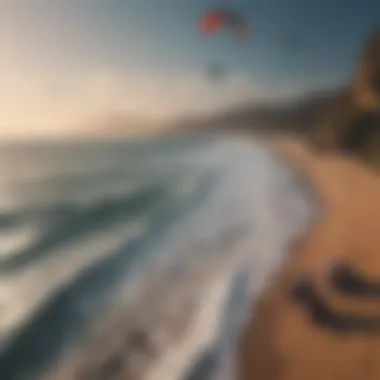

Skill Requirements
The skill requirement for each discipline tends to differ significantly. Wing kitesurfing may allow beginners to pick up basic skills quicker due to its simpler mechanics of control, while kitesurfing can demand a steeper learning curve because of the complexity of controlling a larger kite. Wing kitesurfers benefit from more immediate feedback in their maneuverability. However, the subtlety of skills in kitesurfing—such as kite positioning and balance—ultimately refines one’s abilities further into the sport, often leading to more advanced technical skills.
Accessibility and Learning Curve
When discussing accessibility, wing kitesurfing offers an advantage for newcomers with a generally lower barrier to entry. The equipment tends to be lighter and easier to handle. This aspect contributes to a quicker learning curve for those new to water sports. For traditional kitesurfing, on the other hand, the initial investment in gear and the time required to understand weather dynamics present challenges that might discourage some individuals. Thus, wing kitesurfing opens a gateway for more participants to engage in the sport of their choice.
"When choosing between wing kitesurfing and traditional kitesurfing, consider your local conditions and your personal goals in the water. Both offer unique experiences that can enrich any watersport enthusiast's life."
In summary, the comparative analysis reveals valuable insights into both wing kitesurfing and traditional kitesurfing. Recognizing both the commonalities and differences assists enthusiasts in selecting the right sport for their preferences and enhances the overall sport experience.
Optimal Locations for Wing Kitesurfing
Understanding the optimal locations for wing kitesurfing is essential for anyone looking to engage in the sport. The right environment can greatly enhance the experience, providing suitable conditions for both beginners and experienced surfers. Factors such as wind strength, water conditions, and safety considerations play a significant role in selecting a location.
Top Global Destinations
Beaches and Coastal Areas
Beaches and coastal areas are among the most favored locations for wing kitesurfing. These sites often have consistent winds and plenty of space, catering to different skill levels.
A key characteristic of beaches is the proximity to the ocean, which usually provides clean, unchoppy water. This makes launching and landing much easier for beginners, as well as for those attempting to perform tricks. Furthermore, local surf schools and rental services tend to be concentrated in these areas, making it easy to acquire necessary gear or instruction.
However, it is important to also recognize the disadvantages. Crowded beaches can limit space to maneuver, especially during peak times. Knowledge of the local regulations is crucial as well; some areas may have specific zones designated for kitesurfing.
Lakes and Inland Waters
Lakes and inland waters offer a different set of advantages for wing kitesurfing. Such locations often feature flatter water, which can make it easier for newcomers to learn basic skills and progress quickly.
Lakes tend to have less wind turbulence, allowing for more controlled practice. They also usually feature clearer water and less maritime traffic compared to coastal areas. This can enhance the overall enjoyment and minimize the risks.
On the downside, lakes may experience variable wind conditions depending on the time of year. Some locations may not have as many amenities compared to coastal areas, which can make logistics more complex. Additionally, checking local regulations before heading out is advisable, as rules vary widely between different inland bodies of water.
Regional Variations
Best Time to Visit
The best time to visit a kitesurfing location can vary significantly based on climate, wind patterns, and seasonal tourism. Understanding these factors can lead to a more enjoyable kitesurfing experience.
A key characteristic often found is the wind season. In many regions, there is a specific window when consistent winds prevail. This makes it a popular choice for serious enthusiasts chasing optimal conditions.
Traveling during the off-peak months can also offer advantages like fewer crowds and lower accommodation costs. Nonetheless, be cautious about weather patterns, as off-peak seasons can coincide with rainy or stormy conditions that may not be suitable for kitesurfing.
Local Regulations and Restrictions
Local regulations and restrictions are integral considerations for anyone planning to partake in wing kitesurfing. Understanding where and when you can kite is crucial for ensuring safety and compliance with local laws.
The regulations can include designated kite zones, specific times when kitesurfing is allowed, and restrictions on equipment. Being aware of these factors helps prevent legal issues and accidents while also promoting responsible kitesurfing practices.
For example, some beaches may require permits or have strict limits on the number of people kiting at once. Adhering to these regulations not only keeps you safe but also contributes to the sport’s reputation and sustainability.
"Being informed about location-specific regulations can enhance your kitesurfing experience and safeguard the community's interest."
In summary, selecting an optimal location for wing kitesurfing entails a blend of various factors such as water conditions, wind availability, and local laws. Understanding these elements is vital for maximizing your enjoyment and safety in this thrilling sport.
Community and Culture
The community and culture surrounding wing kitesurfing play a crucial role in supporting and shaping the sport. As more individuals become interested in this activity, the community grows and evolves, fostering connections among enthusiasts. The social dynamics encourage sharing of experiences, knowledge, and skills, which can dramatically enhance a kitesurfer's journey. Additionally, an engaged community helps to host events and promote safety, making it a critical aspect of the sport for both newcomers and experienced riders.
Joining the Wing Kitesurfing Community
Clubs and Organizations
Clubs and organizations designed for wing kitesurfing provide members with a structured way to engage with the sport. These groups often have tailored programs that assist in skill development, safety education, and social interaction. A key characteristic of these clubs is their focus on community-building, which fosters camaraderie among participants.
Joining a club can be beneficial because it often offers access to instructional resources and collective experiences. Members can learn from each other, share tips, and participate in group activities that enhance their skills and knowledge. However, one disadvantage can be the membership costs, which may not be feasible for everyone.
A unique feature of many clubs is the organization of local events that can include training sessions and group outings. These events can be advantageous by providing newer riders with opportunities to practice in a supportive environment.
Social Media Presence
The social media presence of wing kitesurfing has become increasingly significant in fostering attachment among enthusiasts. Platforms like Facebook or Reddit enable users to connect with others in the community to share insights, ask questions, and promote events. The interactivity and accessibility of social media make it a popular choice for engaging with the sport.
A key characteristic of social media is its ability to reach a global audience, helping riders connect with others regardless of location. This dynamic can encourage travel and exploration of new spots, as members often share their local knowledge. However, the downside can be misinformation, where unverified tips and techniques might circulate, leading to misconceptions.
Social media's unique aspect lies in its real-time updates. Participants can discover events or competitions instantly and engage in discussions while thriving in an online community focused on wing kitesurfing.
Events and Competitions
Annual Competitions
Annual competitions in wing kitesurfing serve as a platform for showcasing talents and recognizing achievements within the sport. These competitions often attract participants from diverse backgrounds, enriching the experience for everyone involved. A key characteristic of these competitions is the opportunity for riders to challenge themselves and observe various levels of skill.
Competing in these events can be beneficial—it provides motivation to improve and a chance to learn from more experienced athletes. However, the pressure of competition can sometimes be overwhelming, especially for novices.
Annual events often feature categories for multiple skill levels, which helps to include riders of all backgrounds. They provide a unique setting where participants can interact with industry professionals and explore new gear, leading to valuable insights into advancements in wing kitesurfing.
Local Gatherings and Meetups
Local gatherings and meetups offer a decentralized approach to bonding, allowing enthusiasts to form connections within their geographic area. These informal setups can create welcoming environments, encouraging people to join the sport. A key characteristic is the relaxed, non-competitive atmosphere that often promotes participation among new riders.
These meetups can be beneficial for building local communities, sharing knowledge, and even organizing small-scale events like beach clean-ups or instructional days. One downside, however, may be that they can lack structure compared to formal clubs, potentially leading to inconsistency in quality and attendance.
Local gatherings often focus on ensuring everyone feels welcome, promoting inclusivity, and encouraging more participants to engage in wing kitesurfing. This community-driven aspect enhances the sport's overall environment, fostering a camaraderie that extends beyond just the activity itself.
"Community not only elevates individual experiences, but also amplifies the joy and adventure in wing kitesurfing."
Engaging in the community and culture of wing kitesurfing can significantly enrich the experience for both seasoned athletes and newcomers alike.







